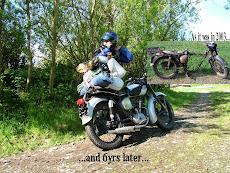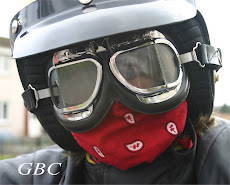I've been trying to get on the BikeSafe course for years, but never got around to it, or remembered to apply in time and all that stuff. This year, after a talk from Grampian Police at the bike club, I pestered all the Grumpy members to go on BikeSafe with me. And some of them did. Not many, but enough to get a group together and make a good showing at Aberdeen police station when we turned up on Sunday for the course. I was pleased - no, amazed to find a total of 3 Triumphs belonging to 'students' and 1 Triumph belonging to the Advanced Motorcyclist who helps out, parked up outside the station, and Cubbie made 5. In case you don't know, there are no tests or exams on the BikeSafe course, it doesn't aim to make you a faster rider, or turn you into an 'advanced' rider, it is merely intended to help make riders more aware, and therefore safer, on the road.
Can't tell you too much, cos that would spoil your enjoyment of reading all about it in Old Bike Mart one day soon, but in brief, the day started with a DVD all about filtering, junctions, overtaking and the like, complete with some rather weird computer simulations of riders doing stupid things and being smashed to bits between cars - all based on real life scenarios, sorry, road traffic collisions. Then we were split into two groups, the one I was in went out on the road first for the observed rides, while the others partook of some up to date first aid advice. The riding was observed by either a police motorcyclist or the advanced rider, and frequent stops allowed for feedback and advice.
After returning to the station a couple of hours later we were most certainly ready for lunch. After that it was our turn for the first aid bit. That was rather good as the speaker demonstrated helmet removal and how to turn a casualty over should it be necessary. Turns out that if you stumble upon a casualty out on the roads, after making sure all is safe, if they're breathing you just leave them be (calling the emergency services goes without saying, I hope!) - no hauling them into the recovery position for risk of damaging the spine, but if they're not breathing, then you must roll them onto their back and 'make' them breath - we were shown the 'new' jaw thrust technique - no more of the tilting the head back to clear the airway, because, again, that would put the spine in danger should there be any injuries to the back or neck. Have to say, I'm not all that confident I could master the jaw thrust, it looked easy when he showed us (it's a bit sore when he demonstrates on your own jaw!), and it sounds easy enough, but in real life....anyway, here's how you do it -
Kneel at the top of the casualty's head.
Rest your elbows on the surface where casualty is lying.
Place one hand on each side of the casualty's lower jaw at the angle of the jaw, below the ears.
Stabilize the casualty's head with your forearms.
Use the index fingers to push the angles of the patient's lower jaw forward.
After that, a guy from a local bike shop who doubles as a Special Constable took us through a bit of bike maintenance, most of which didn't apply to such an ancient machine as Cubbie! Then it was time to go home.
So there it is, I've done it, and so has Cubbie. I'm not convinced that all of the techniques apply to slower machines / riders though. For example, taking a nice long sweeping right-hander, you should place yourself as close to the left hand verge as is safe, thus giving maximum view of the road ahead and any hazards, but with a max warp speed factor of 50mph on Cubbie, I felt that I was giving an open invitation to car drivers to overtake me. So with some more advice, I modified that positioning slightly, and will take such bends a little further in from the verge. And stick my elbows out to make my presence on the road 'greater'. I could have said bigger there but you'd only tell me to eat more chocolate!
All in all, a good day out, and not bad for £20. And besides, what harm can extra advice from professional riders do?
 Then the machine whirrs into life and a few mins later...
Then the machine whirrs into life and a few mins later... The small shield is ready to be positioned, drilled and pinned to the wooden shield...
The small shield is ready to be positioned, drilled and pinned to the wooden shield... Just like this. Sadly I won't be able to attend the S&T this year to defend my title, as I have to be at a local rally - the organisers of which are kindly lending us their marquee for the Plus1. But everyone at the S&T, y'all have a good time now - I can't remember the last time I wasn't there.
Just like this. Sadly I won't be able to attend the S&T this year to defend my title, as I have to be at a local rally - the organisers of which are kindly lending us their marquee for the Plus1. But everyone at the S&T, y'all have a good time now - I can't remember the last time I wasn't there.
























